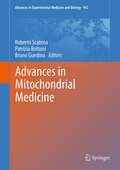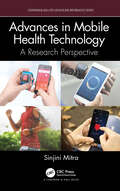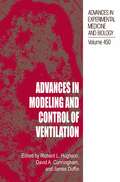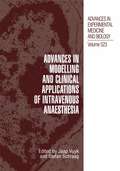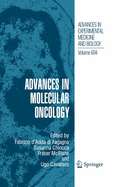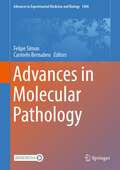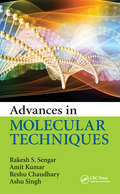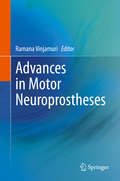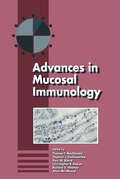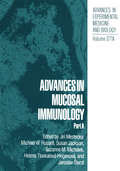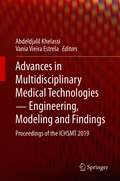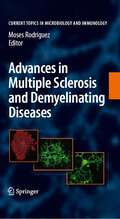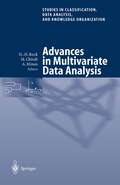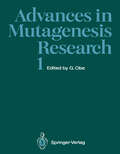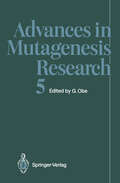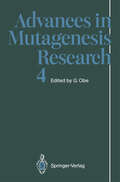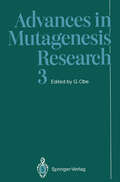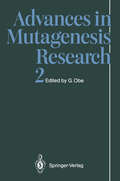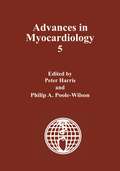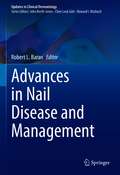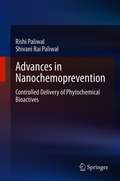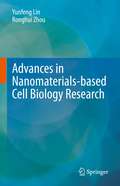- Table View
- List View
Advances in Mitochondrial Medicine (Advances in Experimental Medicine and Biology #942)
by Roberto Scatena, Patrizia Bottoni and Bruno GiardinaMitochondria are far more than the “powerhouse” of the cell as they have classically been described. In fact, mitochondria biological activities have progressively expanded to include not only various bioenergetic processes but also important biosynthetic pathways, calcium homeostasis and thermogenesis, cell death by apoptosis, several different signal transduction pathways mainly related to redox control of gene expression and so on. This functional and structural complexity may undergo important derangements so to justify the definition of ‘mitochondrial medicine’, which should include all the clinical consequences of congenital or acquired mitochondrial dysfunctions. There are actually a growing number of studies which assign a significant pathogenic role to damaged mitochondria in different diseases: ischemia/reperfusion injury, neurodegenerative diseases, cancer with its dramatic sequelae (i.e, metastasis), metabolic syndrome, hyperlipidemias, just to mention a few of the most important pathologies. In this context, a further aspect that should not be disregarded is the interaction of pharmacological agents with mitochondria, not only in regard of the toxicological aspects but, above all, of the potential therapeutic applications. In fact, it is interesting to note that, while the properties of different so-called “mitoxicants” are well-known, the subtle linkages between drugs and mitochondria is still in need of a real pharmacological and therapeutic control at the clinical level. This lack of consideration can often lead to an underestimation of unwanted toxic effects but also of desirable therapeutic activities. A reevaluation of the potential clinical role of mitochondria could give a new light on some yet obscure aspects of human pathophysiology.
Advances in Mobile Health Technology: A Research Perspective (Chapman & Hall/CRC Healthcare Informatics Series)
by Sinjini MitraThe COVID-19 pandemic upended the lives of many and taught us the critical importance of taking care of one’s health and wellness. Technological advances, coupled with advances in healthcare, has enabled the widespread growth of a new area called mobile health or mHealth that has completely revolutionized how people envision healthcare today. Just as smartphones and tablet computers are rapidly becoming the dominant consumer computer platforms, mHealth technology is emerging as an integral part of consumer health and wellness management regimes. The aim of this book is to inform readers about the this relatively modern technology, from its history and evolution to the current state-of-the-art research developments and the underlying challenges related to privacy and security issues. The book’s intended audience includes individuals interested in learning about mHealth and its contemporary applications, from students to researchers and practitioners working in this field. Both undergraduate and graduate students enrolled in college-level healthcare courses will find this book to be an especially useful companion and will be able to discover and explore novel research directions that will further enrich the field.
Advances in Mobile Health Technology: A Research Perspective (Chapman & Hall/CRC Healthcare Informatics Series)
by Sinjini MitraThe COVID-19 pandemic upended the lives of many and taught us the critical importance of taking care of one’s health and wellness. Technological advances, coupled with advances in healthcare, has enabled the widespread growth of a new area called mobile health or mHealth that has completely revolutionized how people envision healthcare today. Just as smartphones and tablet computers are rapidly becoming the dominant consumer computer platforms, mHealth technology is emerging as an integral part of consumer health and wellness management regimes. The aim of this book is to inform readers about the this relatively modern technology, from its history and evolution to the current state-of-the-art research developments and the underlying challenges related to privacy and security issues. The book’s intended audience includes individuals interested in learning about mHealth and its contemporary applications, from students to researchers and practitioners working in this field. Both undergraduate and graduate students enrolled in college-level healthcare courses will find this book to be an especially useful companion and will be able to discover and explore novel research directions that will further enrich the field.
Advances in Modeling and Control of Ventilation (Advances in Experimental Medicine and Biology #450)
by Richard L. Hughson David A. Cunningham James DuffinProceedings of a Symposium held in Huntsville, Canada, September 17-21, 1997
Advances in Modelling and Clinical Application of Intravenous Anaesthesia (Advances in Experimental Medicine and Biology #523)
by Jaap Vuyk Stefan SchraagSince its launch in 1998 the European Society for Intravenous Anaesthesia (EuroSIVA) has come a long way in providing educational material and supporting the research and clinical application of intravenous anaesthesia. After the first two annual meetings held in Barcelona and Amsterdam in 1998 and 1999, three other successful meetings took place in Vienna, Gothenburg and Nice in 2000, 2001 and 2002. Next to these main meetings, starting in the year 2000, a smaller winter meeting has been organised every last week of January in Crans Montana, Switzerland. Both the main summer and the winter meetings breathe the same atmosphere of sharing the latest on intravenous anaesthesia research in the presence of a friendly environment and good company. Since the first meetings the educational tools of EuroSIVA have increased in quantity and technical quality allowing digital slide and video presentation along with the use of the computer simulation program TIVAtrainer during the speaker sessions and the workshops. Furthermore, EuroSIVA now exploits a website www. eurosiva. org that allows for continuous exchange of information on intravenous anaesthesia, the TIVAtrainer, the EuroSIVA meetings and online registration for these meetings. The EuroSIVA is currently engaged in friendly contacts with the Asian Oceanic Society for Intravenous Anaesthesia (AOSIVA), the United Kingdom Society for Intravenous Anaesthesia (UKSIVA), the Korean Society for Intravenous Anaesthesia (KSIVA), the European Society of Anaesthesiology (ESA) and the International Society for Applied Pharmacology (ISAP).
Advances in Molecular Oncology (Advances in Experimental Medicine and Biology #604)
by European Institute of Oncology Institute of Molecular OncologyProceedings of the 2nd Annual IFOM-IEO Meeting on Cancer. This is a new meeting, it has about 200 attendees from Australia, Austria, Belgium, Brazil, Canada, England, France, Germany, Greece, Ireland, Italy, Japan, Netherlands, Spain, Sweden, Switzerland, and the USA. The 2nd IFOM-IEO international meeting on cancer will provide a forum in which the world’s leading cancer researchers and young scientists will discuss the latest advances in molecular oncology. The impact of recent breakthroughs in basic research and of emerging technologies on molecular medicine in cancer will be highlighted.
Advances in Molecular Pathology (Advances in Experimental Medicine and Biology #1408)
by Felipe Simon Carmelo BernabeuThe present work corresponds to a compilation of independent contributions in the fields of endocrinology, immunity, cancer, neurobiology, and myology. Revision of current advances as well as novel findings in the form of original articles are presented in a balanced fashion. The book has been divided into three sections in line with the main subject: Molecular pathology of immune, inflammatory, and hemostatic disorders; Molecular pathology of endocrine and muscular disorders; and Molecular pathology of cancer: determinants and potential therapies. In the first section, contributing authors take the reader through the molecular pathology of immune responses, inflammation, and hemostasis, by collating an update on systemic autoimmune diseases, the therapeutic potential of statins in hemostasis, the effects of adrenergic stimulation on coagulation, the emerging field of physical burnout due to the mobility restrictions in response to the 2020 SARS-CoV-2 pandemic imposed worldwide, and the success of community-oriented muscular kinesic rehabilitation. The second section presents engaging results from a survey of iodine intake through the diet of pregnant females, an appraisal of the neuroprotective effect of dexmedetomidine, novel evidence on muscle physiopathology, describing the upregulation of CCL5/RANTES during cholestatic liver disease, the fibrotic response emerging in response to cholic and deoxycholic acids, and the altering effects of bile acids in autophagy and mitogenesis. In the third section, a comprehensive revision of cancer literature is offered with an emphasis on melanoma, myeloid-derived suppressor cells, microRNA-based diagnostic approaches, and new avenues for cancer immunotherapy. Altogether, these individual contributions offer a comprehensive and up-to-date outlook of the current state in the field of molecular pathology.Chapter 14 is available open access under a Creative Commons Attribution 4.0 International License via link.springer.com.
Advances in Molecular Techniques
by Amit Kumar Ashu Singh Rakesh S. Sengar Reshu ChaudharyMolecular genetics aims to comprehend biological activity at the gene sub-level. Scientists from different areas of research and applied science can use the standard techniques optimized by molecular biologists.This book serves as a guide that introduces classic molecular biology techniques and advances in molecular and genetic engineering.
Advances in Molecular Techniques
by Amit Kumar Ashu Singh Rakesh S. Sengar Reshu ChaudharyMolecular genetics aims to comprehend biological activity at the gene sub-level. Scientists from different areas of research and applied science can use the standard techniques optimized by molecular biologists.This book serves as a guide that introduces classic molecular biology techniques and advances in molecular and genetic engineering.
Advances in Motor Neuroprostheses
by Ramana VinjamuriThis book provides a comprehensive review of recent developments in the field of motor neuroprosthetics and brain-machine interfaces. Chapters in this book are provided by leading experts in the field and include topics such as the design and control of multidimensional prosthetics and exoskeletons, deep brain stimulation, functional electrical stimulation, deep learning for brain machine interfaces, biofeedback, and cognitive intent for adaptation of motor prostheses. This book is a great resource for undergraduate and graduate students, researchers, engineers from related disciplines, entrepreneurs, and anyone interested in the latest progress in the field of motor neuroprostheses.
Advances in Mucosal Immunology: Proceedings of the Fifth International Congress of Mucosal Immunology
by S. Challacombe P. Bland C. Stokes A. Heatley A. MowatThe immunology of mucosal surfaces is one of the most exciting and relevant areas of medical veterinary and dental research since it applies basic research to tissues in volved in everyday defence against microbes and against environmental and food antigens. This book is based on the contributions presented at the International Con gress of Mucosal Immunology, held in London in July 1989 and organised by the Mu cosal Immunology Affinity Group of the British Society for Immunology. The meet ing was attended by over 500 delegates from 27 countries, including virtually all of the leading investigators in the field. The contents give comprehensive and up-to date information on such topics as antigen presentation and processing in the gut, mucosal vaccines in man and animals, HIV infection in the gut, the role of yo T cells in the gut epithelium, recent advances in inflammatory bowel disease and coeliac dis ease, the role of cytokines in the regulation of the IgA response, mucosal mast cells and cell migration. The contributions reflect the rapid pace of research in mucosal immunology, and the great strides which are taking place in the understanding of the immunology, molecular biology and biochemistry of host response at mucosal sur faces.
Advances in Mucosal Immunology: Part A (Advances in Experimental Medicine and Biology #371)
by Jiri Mestecky Michael W. Russell Susan Jackson Suzanne M. Michalek Helena TlaskalováHogenová Jaroslav SterzlThe Seventh International Congress of Mucosal Immunology held in Prague, the beautiful old capital of The Czech Republic, 16-20 August 1992, was the first to be sponsored by the Society for Mucosal Immunology, and was the largest since their inception 20 years earlier in Birmingham, Alabama. It was attended by 624 participants who gave 538 presentations, more than 10 times the numbers of the first meeting; these proceedings contain 354 papers that were submitted for publication. The political events in Europe that made it possible to hold this Congress in Prague also allowed for the first time the participation of large numbers of scientists from Eastern Europe, as weil as from Asia, and the organizers were truly gratified by this happy circumstance. It is now clear not only that mucosal immunityencompasses the huge area of mucosal surfaces and most physiological organ systems, but also that mucosal immunology extends over the whole global surface and all continents! The sheer size of the Congress and number of manuscripts unfortunately entailed some unexpected problems in editing and assembling the proceedings, partly due to the diversity of linguistic styles not represented at earlier meetings, and we apologize to the authors who have patiently awaited the publication of their contributions.
Advances in Multidisciplinary Medical Technologies ─ Engineering, Modeling and Findings: Proceedings of the ICHSMT 2019
by Abdeldjalil Khelassi Vania Vieira EstrelaThis book collects the proceedings of the International Congress on Health Sciences and Medical Technologies (ICHSMT), held in Tlemcen, Algeria, from December 5 to 7, 2019. The proceedings present a forum for the latest projects and research in scientific and technological development with an emphasis on smart healthcare system design and future technologies. ICHSMT brings together researchers, students, and professionals from the healthcare, corporate, and academic sectors. It includes a far-reaching program supported by a variety of technical tracks that seek to promote medical technologies and innovation at a nationwide level.
Advances in Multiple Sclerosis and Experimental Demyelinating Diseases (Current Topics in Microbiology and Immunology #318)
by Moses RodriguezControversy still exists regarding how early disease-modifying agents (DMA) should be commenced and whether all patients with relapsing-remitting MS should in fact be treated. To answer these questions, it is also important to know the natural history of the disease. MS affects nearly 400,000 people in the United States. With their novel, multifaceted approach to basic science, the authors of this book offer help to clinicians and hope to patients.
Advances in Multivariate Data Analysis: Proceedings of the Meeting of the Classification and Data Analysis Group (CLADAG) of the Italian Statistical Society, University of Palermo, July 5–6, 2001 (Studies in Classification, Data Analysis, and Knowledge Organization)
by Hans Hermann Bock Marcello Chiodi Antonio MineoThe book presents a range of new developments in the theory and practice of multivariate statistical data analysis. Several contributions illustrate the use of multivariate methods in application fields such as economics, medicine, environment, and biology.
Advances in Mutagenesis Research (Advances in Mutagenesis Research #1)
by M. Bauchinger F. K. Ennever H. Hayatsu R. Huber C. Kessler I. Mellon H. Nöthel C. A. Smith R. M. SpeedThe new field of applied genetic research, genetic toxicology and mutation research investigates the mutagenicity and cancerogenicity of chemicals and other agents. Permanent changes in genes and chromosomes, or genome mutations, can be induced by a plethora of agents, including ionizing and nonionizing radiations, chemicals, and viruses. Mutagenesis research has two aims: (1) to understand the molecular mechanisms leading to mutations, and (2) to prevent a thoughtless introduction of mutagenic agents into our environment. Both aspects, namely, basic and applied, will be treated in the new series Advances in Mutagenesis Research.
Advances in Mutagenesis Research (Advances in Mutagenesis Research #5)
by Y. F. Bogdanov E. Dikomey N. A. Liapunova W. U. Müller C. StrefferApplied genetic research, genetic toxicology and mutation research investigate the mutagenicity of chemicals and other agents. Permanent mutation in genes and chromosomes can be induced by a plethora of agents, including ionizing and nonionizing radiations, chemicals, and viruses. Among the aspects discussed in Advances in Mutagenesis Research are: 1. The understanding of the molecular mechanisms leading to mutations, and 2. the prevention of a thoughtless introduction of mutagenic agents into the environment.
Advances in Mutagenesis Research (Advances in Mutagenesis Research #4)
by F. Cortes P. Escalza A. Hofmann V. I. Ivanov H. Kasai G. Klopman G. Korge N. A. Liapunova S. Nishimura N. Paweletz B. Richards H. S. Rosenkranz M. Ruiz-Rubio M. M. Shahin B. K. Vig R. D. Wegner D. WildAdvances in Mutagenesis Research (Advances in Mutagenesis Research #3)
by H. H. Evans D. Frankenberg M. Frankenberg-Schwager E. Gebhart W. Köhnlein R. H. Nussbaum D. G. Papworth J.R.K. Savage R. D. WegnerApplied genetic research, genetic toxicology and mutation research investigate the mutagenicity and cancerogenicity of chemicals and other agents. Permanent mutation in genes and chromosomes, can be induced by a plethora of agents, including ionizing and nonionizing radiations, chemicals, and viruses. Among the aspects discussed by Advances in Mutagenesis Research are (1) the understanding of the molecular mechanisms leading to mutations, and (2) the prevention of a thoughtless introduction of mutagenic agents into the environment.
Advances in Mutagenesis Research 2 (Advances in Mutagenesis Research #2)
by E. E. Castilla R. Drouin J. Filipski E. Gebhart G. P. Holmquist P. Kasper J.S. Lopez-Camelo S. Madle K. Müller L. Müller J. Piper J. Pohl-Rüling C. L. Richer T.M. Schroeder-Kurth R. SodThe new field of applied genetic research, genetic toxicology and mutation research investigates the muta- genicity and cancerogenicity of chemicals and other agents. Permanent changes in genes and chromosomes, or genome mutations, can be induced by a plethora of agents, including ionizing and nonionizing radiations, chemicals, and viruses. Mutagenesis research has two aims: (1) to understand the molecular mechanisms leading to mutations, and (2) to prevent a thoughtless introduction of mutagenic agents into our environment. Both aspects, namely, basic and applied, will be treated in the new series Advances in Mutagenesis Research.
Advances in Myocardiology: Volume 4
by E. Chazov V. Saks G. RonaThis volume of Advances in Myocardiology is derived from a part of the proceedings of the 10th Congress of the International Society for Heart Research, which was held in Moscow on September 23-29, 1980. This book contains selected papers which have been arranged in two sections, Cardiac Hypertrophy, Adaptation, and Pathophysiology and Cardiac Hypoxia, Is chemia, and Infarction. The first section, on the pathophysiology of heart hypertrophy and failure, contains 24 chapters that focus on the derangement of biochemical, physiological, and immunological processes during the de velopment of heart disease due to a wide variety of pathogenic factors. Some of the recent developments in understanding the myocardial synthetic ma chinery in heart hypertrophy are also described in these papers, and we believe that the contents of this section will stimulate further research in the area of heart disease. The second section, which mainly deals with myocardial ischemia, contains 35 chapters providing the necessary back ground for the diagnosis of ischemic heart disease and some possible ther apeutic approaches. It hardly needs to be emphasized that ischemic heart disease is a major cause of death in highly industrialized countries, but unfortunately the exact mechanism by which ischemic insult leads to the development of heart cell damage is far from understood. We are hopeful that the articles in this section will provide valuable information in this field and thus will help in improving the treatment of ischemic heart disease.
Advances in Myocardiology (Advances in Mycocardiology)
by Peter HarrisThe Eleventh World Congress of the International Society for Heart Re search 1983 provided an opportunity to review some of the growing points in our knowledge of the structure and function of the myocardium. Those at the meeting will recall how London suddenly went tropical. Yet aseries of scintillating reviews held over six hundred scientists captive in the lecture halls of Imperial College. There were sessions on nuclear magnetic reso nance, the molecular basis of electrophysiology, calmodulin, protein syn thesis and degradation, oxygen free radicals, the structural components of the myocyte, sarcolemmal sodium exchange, and the influence of lipids on membranes. Here we have gathered together, as quickly as possible, a number of the presentations of the speakers invited to the symposia. They give, we believe, a striking picture ofthe diversity oftechnology and scientific enquiry which underlies this immensely active domain of modern cardiology. If only our clinical colleagues were more aware of it! Peter Harris Philip A. Poole-Wilson London v Contents Evolution, Cardiac Failure, and Water Metabolism: Presidential Address . . . . . . . . . . . . . . . . . . .
Advances in Nail Disease and Management (Updates in Clinical Dermatology)
by Robert L. BaranThis book serves as a concise text on nail diseases and disorders, offering the most up to date information available from internationally recognized speakers and authors. This comprehensive guide examines a multitude of nail disease types manifestations, treatments, and complications. Chapters delve into specific disorders such as yellow nail syndrome, psoriasis, lichen planus, and brittle nails. Notable treatments covered include advances in MRI, anti-neoplastic drugs and ultrasound imaging. The book also features discussions on unique topics, such as the convergence of orthopedics and onychology in nail disease treatment, as well as treatment complications faced by distinct demographics. Going beyond basics and diving right into the heart of various diseases and disorders, Advances in Nail Disease and Management will serve to aid experienced dermatologists looking for advanced expertise information.
Advances in Nanochemoprevention: Controlled Delivery of Phytochemical Bioactives
by Rishi Paliwal Shivani Rai PaliwalThis book discusses the recent progress and advances in nanochemoprevention. Chemoprevention utilizes natural dietary compounds and has regained interest due to larger safety window and proven efficacy of such molecules in cancer treatments. Nanotechnology has revolutionized drug delivery through passive as well as active targeting. This book provides a comprehensive overview of phytochemical bioactives that are used in chemoprevention. It gives a comprehensive overview of the variety of natural molecules and types of nanoparticles as well as mechanistic aspects of their superior efficacy over plain drug molecules. The book concludes with summarizing the progress of pre-clinical results of developed formulations for cancer treatment using nano-chemoprevention.
Advances in Nanomaterials-based Cell Biology Research
by Yunfeng Lin Ronghui ZhouThis book aims to comprehensively summarize the current research status of nanomaterials and cell biology. It highlights the biological effects and biomedical applications of nanomaterials for specific diseases, bone tissue engineering, and skeletal muscle regeneration. It also provides the details of the biomedical applications of nucleic acid nanomaterials in drug delivery carriers, antimicrobial therapy, vaccine, and neurodegenerative diseases. Therefore, this book renders the audience a better understanding of nanomaterials along with the diverse applications in the cell biology field from recent works to perspectives.
